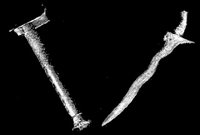Man has, ever as long as it can be remembered, yearned for the secrets and key to immortality. There are many reasons for this. Reasons which does not need further illustration if one is closely acquainted to the nature of man himself. There are countless stories depicting discoveries over Fountains of youth and also other key factors that might make man an immortal such as attaining invulnerability.
In the olden days, mysticism attributed to attaining invulnerability was not so uncommon though it was an almost general practice, but unnecessarily exclusively confined to, for warriors. It is not difficult to understand the logic behind a warrior’s need for this attainment: a facet to make one invulnerable to the weapons of the enemy. Therefore, this aspect of mystic art became an essential part of the training for neophytes aspiring to become great warriors.
However, this desire was not so easily achieved. Subjects undergo lengthy and arduous period to prepare themselves for this journey of attainment. They are required to fast and meditate as well as performing esoteric rituals and incantations.
There are many Malay warriors that boasts this uncanny ability through myths and legends but none are as popular and famed as the legendary Laksmana Hang Tuah, an admiral of the Malaccan Sultanate in the 16th century, whose daring and colourful exploits were mentioned even in China.
There is a record of his account (Hikayat Hang Tuah by R.O. Winstedt, p. 118) while returning to the port of Malacca after a visit to Southern India, his ship was surrounded and attacked by four heavily armed Portuguese caravals. It was written that enemy’s guns couldn’t fire after he read out some incantations.
A few years later, again his ship was attacked, this time just off the coast of the Malay state of Patani. Javanese raiders attempted to board his ship and with a display of occult power, he caused the guns of these pirates to just emit smoke and their swords to fall harmlessly at their sides (Ibid pg 119).
Malay magicks that ciphers invulnerability exists in numbers that allows classification. The native Malay term for invulnerability is kebal.(The list can be found in Malaysian Magic. W. Shaw. Pg 14)
- Kebal Minyak
In which oil rubbed onto the body during initiation is thought to impart some magical quality to the skin which causes weapons to slide off of it, leaving the invulnerable man unharmed.
- Kebal Pakan
Invulnerability attained by means of charms, drugs or the ritual repetition of magic formulae, which cause an enemy’s weapon either to break on striking the protected body, or to be deflected so that it misses altogether.
- Kebal Kulit Nangka aka Kebal Katak Puru
Invulnerable because the skin is impenetrable to weapons.
- Kebal Daging
Here, it is the flesh that is impenetrable, though the skin may be cut or injured with consequent superficial bleeding.
- Kebal Penimbul
From timbul (rising to the surface), with the sense that something magical rises to the under surface of the skin to intercept a weapon or missile and prevent its further penetration. Usually used in the form of Kebal Penimbul Raksa (raksa- mercury or quicksilver) when the quicksilver that has been rubbed into the body during initiation (aka susuk) appears wherever iron, steel or lead has penetrated and thereon bars its further progress.
- Kebal Sampul
From sampul, a caul, a membrane that sometimes envelopes a baby’s head at birth. A child born with a complete caul is considered by many to be invulnerable.


<< Home